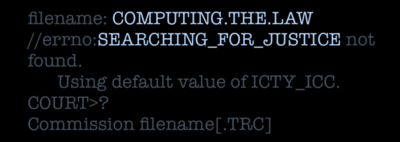Difference between revisions of "Exe0.2 Geraldine Juárez"
Jump to navigation
Jump to search
| Line 1: | Line 1: | ||
=Execution as deterritorialization= | =Execution as deterritorialization= | ||
==== | ====Introduction==== | ||
====Technocolonialism: a definition==== | |||
Location: Malmö University, Niagara building, Room NI:B0E15 (on the ground floor), Nordenskiöldsgatan 1, 211 19 Malmö, Sweden | Location: Malmö University, Niagara building, Room NI:B0E15 (on the ground floor), Nordenskiöldsgatan 1, 211 19 Malmö, Sweden | ||
Revision as of 22:44, 17 April 2016
Execution as deterritorialization
Introduction
Technocolonialism: a definition
Location: Malmö University, Niagara building, Room NI:B0E15 (on the ground floor), Nordenskiöldsgatan 1, 211 19 Malmö, Sweden
16.00 Reception
16.15 Introduction of the event
16.30 Femke Snelting keynote: "Modifying the universal: an interim report"

- In 2014, The Unicode Consortium decided to add five "Skin tone modifiers" to the ISO 10646 standard that encodes more than 800 emoji characters. Currently, a new proposal is under discussion for a mechanism that would allow further customizations. If accepted, this will ensure that gender variants (such as female runners or males raising a hand), hair color variants (a red-haired police woman), and directional variants (pointing a gun or a crocodile to the right, rather than only to the left) can be encoded.
- Unicode is a set of standards, an underlying infrastructure that impacts all use of text on computers, mobile devices and the web. Aiming to include all languages written in the world, Unicode does not prescribe particular fonts or specific renderings of characters, but simply provides a number for each character used in a text. While it might seem that the Unicode Consortium solved the diversity issue by adding modifiers, they actually opened a pandoras box. While the "modifiers" function within the universalist belief-system of Unicode, they start to function as encoded means for segregation. In it's shadow we see the re-appearance of the gender-neutral as a norm, and whiteness as the absence of ethnicity. As the Standards Body insists on importing existing conventions, not at any moment the colonial assumptions underlying the system of encoding is being questioned. The mechanisms are merely techno-centric patches in response to the increasing complexity of cross-device and cross-cultural computing, a situation that demands a re-imagination of compatibility in terms of difference.
- Technological systems increasingly represent, form and interact with diverse physical bodies. The bankruptcy of the idea that anything is possible and that networked technologies are a-political spaces for becoming, means that we need to radically rethink what it means to say 'everyone'. In an era that is apparently "post- racial" and "post-gender" we see an actual backlash of racism and sexism, in terms of discrimination on one side, and affirmation on the other side; the emoji standards reflect this tension. If we co-exist with software, what generative forms of representation in/through software can we imagine, that not only represent multiplicity but allow us to materialise it, beyond the Modern regime of universality? What are the possibilities of a politics, aesthetics and ethics that is truly generative? How can we think other futures for computing, so that another type of possible becomes possible?
- The talk and workshop are developed by Peggy Pierrot, Roel Roscam Abbing and Femke Snelting in the context of Possible Bodies, an ongoing collaboration between artists, programmers, performers and activists that are concerned with the specific entanglements of technology, representation and normativity that (re)-appear through renderings of the virtual. A complete description of the talk together with suggested reading materials can be read here.
17.00 Susan Schuppli keynote: "Computing the Law // Searching for Justice"

- This talk explores two distinct mechanisms that have responded to the injustices of conflict and war in ways that are suggestively computational. The forums of the International Criminal Tribunal with their elaborated “Rules of Procedure and Evidence” have, I argue, transformed the juridical apparatus into a quasi-machinic set of operations that compress the affective realm of experience through the legal strictures of testimony and cross-examination. Moreover, the protocols that govern what counts as a evidence and who counts as a witness are scrupulously attended to, such that the subjective dimensions of testimony and the expressive qualities of material evidence are systematically flattened and disarticulated of all affect as witnesses and exhibits moves through the circuitry of the court. By contrast the Truth and Reconciliation Commission, which has no legal mandate but is organised by a quest for justice and ethical demand that the perpetrator of violence account for and admit to wrong-doing might be characterised as a kind of “incomputable object, one that operates in excess of calculation. The distressing and often-times novel forms of exchange between victims and perpetrators, which includes re-enactments and the performance of cultural rituals produces a surfeit of information that is not conditioned by legal codes that would render such expressive forms of testimony subservient or inadmissible. Unlike the rule-based logic that organises the Criminal Tribunal, the affective processes of the Truth Commission can’t be fully captured by an instrumental or algorithmic conception of justice. A complete description of the talk together with suggested reading materials can be read here.